Chartbook #3:
Nursing Home Trends, 1987 and 1996
By Jeffrey A. Rhoades, Ph.D., Nancy A. Krauss, M.S.
Contents
Executive Summary
How have the nursing home market and characteristics of the nursing home population changed from 1987 to 1996?
Facilities
- There were 14,050 nursing homes with a total of 1.48 million beds in 1987, compared to 16,840 nursing homes and 1.76 million beds in 1996. The number of nursing homes and the number of nursing home beds both increased almost 20% from 1987 to 1996.
- The proportion of nursing homes certified by both Medicare and Medicaid (dually certified) rose from 28% in 1987 to 73% in 1996. Meanwhile, the proportion certified by Medicaid only fell from 50% in 1987 to only 17% in 1996. Passage of the Omnibus Budget Reconciliation Act of 1987 reduced the incentive to remain certified by Medicaid only.
- Growth in the elderly population has outpaced growth in the supply of nursing home beds. The supply of nursing home beds for people 75 years and over dropped
8% from 1987 to 1996—from 127 to 117 beds per 1,000 people this age.
Special Care Units
- In 1996 the most common type of special care unit was for treatment of Alzheimer's and related dementias. Most Alzheimer's units are relatively new; only 10% have been operating for more than 10 years.
Residents
- Nursing homes are caring for an older population now. From 1987 to 1996, the proportion of nursing home residents who were 85 and over rose from 49% to 56% for women and from 29% to 33% for men.
- Male residents were more likely to be married when entering a nursing home in 1996 than in 1987. In 1987, 24.8% of males were married at the time of the interview, while 29.6% had never been married. In 1996, 34.3% of males were married (an increase of 38.3%), while 21.5% had never been married (a 27.4% decline from 1987). There was very little change in the patterns of marital status for female residents over the same period.
- Functional disability has increased. Almost 72% of 1987 nursing home residents-but 83% of residents in 1996—needed help with three or more activities of daily living, a 15% increase.
Throughout this report, a nursing home is defined as having at least three beds and being either certified by Medicare or Medicaid or licensed by a government agency as a nursing home and providing 24-hour skilled nursing care.
Return To Table Of Contents
Introduction
Nursing Home Policy
Nursing homes serve only a minority of the functionally impaired elderly, but nursing home care dominates long-term care financing. State and Federal spending for nursing homes amounted to $80 billion in 1995 (Burner and Waldo, 1995).
With increasing life expectancy and a growing population with functional impairments, meeting long-term care needs will continue to be a challenge. Demand for nursing home care could require 600,000 new beds by 2010 (Porter and Witek, 1991). The magnitude of expenditures and potential for growth in demand have drawn the attention of policymakers and researchers.
This report presents the latest available information concerning three key elements related to nursing home care. The first section of the report presents data on the nursing home market from 1987 to 1996. The second section addresses special care units within nursing homes, such as designated units for Alzheimer's disease. Only 1996 data on special care units are shown because there are no 1987 data. Finally, the third section of the report turns its focus to the characteristics of nursing home residents in 1987 and 1996.
For this report, a nursing home is defined as having at least three beds and being either certified by Medicare or Medicaid or licensed by a government agency as a nursing home and providing 24-hour skilled nursing care. Some other surveys, including the National Nursing Home Survey conducted by the National Center for Health Statistics, use a broader definition of nursing home that does not require the facility to provide round-the-clock nursing care (Strahan, 1987 and 1997).
Return To Table Of Contents
Sources of Data for This Report
The estimates presented in this report are drawn from the 1996 Medical Expenditure Panel Survey (MEPS) Nursing Home Component (NHC) and the 1987 National Medical Expenditure Survey (NMES) Institutional Population Component (IPC). Both surveys are designed to provide extensive data on the types of health care services Americans use, how frequently they use them, how much is paid for the services, and who pays for them. The NHC and IPC are nationally representative surveys, sponsored by the Agency for Health Care Research and Quality (AHRQ) to collect detailed information specifically on nursing homes and nursing home residents with regard to facility and resident characteristics, and use of and expenses for nursing home and health care services.
The estimates presented here are nationally representative of nursing homes and their residents. Estimates for residents are based on a sample of current residents. Current residents are sampled persons living in a nursing home at the beginning of the data collection reference period, January 1 of 1987 or 1996. Unless otherwise noted, only differences that are statistically significant at the 0.05 level are discussed in the text. In some cases, the totals on tables or figures may not add precisely to 100% as a consequence of rounding.
MEPS data are released to the public in a number of formats, including public use data files and the printed MEPS Research Findings and MEPS Highlights series. The numbers shown in this chartbook are drawn from a variety of the Research Findings reports, as well as additional analyses conducted by the MEPS staff. The sources of information are listed in the references at the end of this report.
Return To Table Of Contents
Section 1—Facilities
Data on the nursing home market are critically important because of the dramatic growth in the number of Americans age 75 and over and the desire to minimize the length of expensive inpatient hospital stays. While the trend in long-term care is toward expansion of community-based care for persons with functional limitations, some people need 24-hour skilled nursing care. The need for different types and levels of long-term care has resulted in an increasing number of options for obtaining care. Given these changes in the long-term care market, it becomes increasingly important to make clear and consistent distinctions among the different kinds of facilities that lie along the continuum of care. A better understanding of the current nursing home market, as defined in this report, and the changes from 1987 to 1996 can contribute to informed decisions about the provision of long-term care.
How has the size of the nursing home market changed from 1987 to 1996?
The number of nursing homes increased by 19.9% and the number of nursing home beds by 18.9% from 1987 to 1996.
- In 1987 there were 14,050 nursing homes in the United States, for a total of 1.48 million beds.
- In 1996 there were 16,840 nursing homes, for a total of 1.76 million beds.
- The average size of a nursing home did not change significantly from 1987 (105.3 beds) to 1996 (104.5 beds).
Return To Table Of Contents
See Technical Note 1.
| Nursing homes |
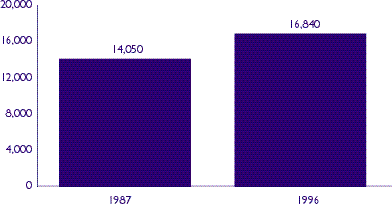 |
| |
| Nursing home beds |
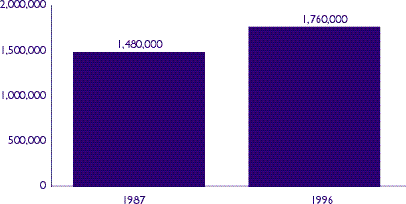 |
| |
Return To Table Of Contents
Has the structure of the nursing home changed?
The 9-year period from 1987 to 1996 saw a trend away from traditional nursing homes (nursing homes with only nursing home beds) and a move toward nursing homes that included assisted or independent living beds in addition to nursing home beds.
- In 1987 fully 87.4% of nursing homes had only nursing home beds. This proportion decreased to 77.3% in 1996.
- Conversely, the proportion of nursing homes that were hospital based or had affiliated non- nursing beds (e.g., assisted or independent living beds) increased. The proportion of hospital-based nursing homes rose from 5.7% in 1987 to 11.4% in 1996. The proportion with affiliated non-nursing beds rose from 6.9% to 11.3% in the same time period.
Nursing home structure
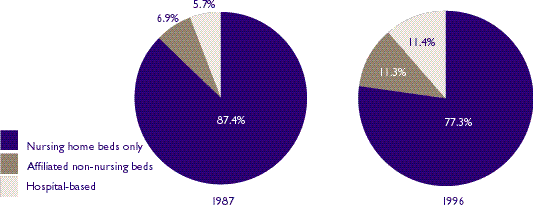
Return To Table Of Contents
Have there been changes in ownership type?
Nursing home ownership remained relatively stable from 1987 to 1996; there were no statistically significant differences between the two years.
- The nursing home market remained largely proprietary.
- The proportion of for-profit homes was 70.1% in 1987 and 65.9% in 1996. The proportion of nonprofit homes was 21.9% in 1987 and 26.2% in 1996. These differences were not statistically significant.
- The remaining 8% of homes in both years were owned by Federal, State, or local governments.
Nursing home ownership

Return To Table Of Contents
How has the certification status of nursing homes changed?
The Omnibus Budget Reconciliation Act of 1987 reduced the incentive for a facility to remain Medicaid certified only. How has the certification status of nursing homes changed since its enactment?
The distribution of nursing homes among the different types of certification changed dramatically from 1987 to 1996.
- In 1996 fully 73.2% of all nursing homes were certified by both Medicaid and Medicare (dually certified). In 1987 only 27.8% were dually certified.
- Conversely, in 1996 just 17.0% of all nursing homes were certified by Medicaid only, compared to fully 49.5% in 1987. Medicare-only certified nursing homes made up 5.0% of the market in 1996, down from 19.5% in 1987.
- In both years, a very small percentage, less than 5%, of all nursing homes were certified neither by Medicare nor Medicaid.
Nursing home certification status
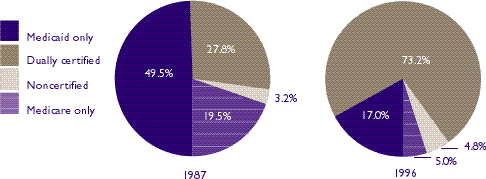
Return To Table Of Contents
Do for-profit nursing homes differ structurally from nonprofit and government facilities?
In both 1987 and 1996, the for-profit segment of the nursing home market was nearly entirely represented by nursing homes with only nursing home beds, as opposed to other more organizationally complex nursing home types (nursing homes with affiliated non-nursing beds and hospital-based nursing homes). Nonprofit and government facilities were more likely than for-profit facilities to have affiliated non-nursing beds, such as assisted or independent living beds.
- In 1996, 90.9% of for-profit nursing homes contained only nursing home beds as compared to 96.9% in 1987.
For-profit
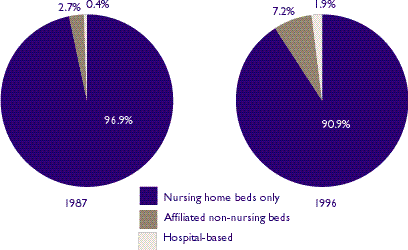
- In 1996, 20.8% of nonprofit nursing homes had affiliated non-nursing beds (e.g., assisted or independent living beds), 2 percentage points less (but not significantly less) than in 1987.
- 7.2% of for-profit nursing homes had affiliated non-nursing beds in 1996, representing an increase of 4.5 percentage points over 1987.
Return To Table Of Contents
Nonprofit
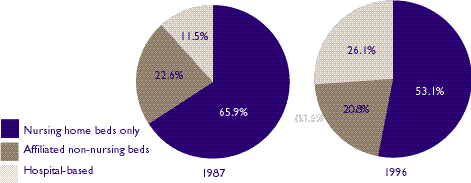
Return To Table Of Contents3
Government
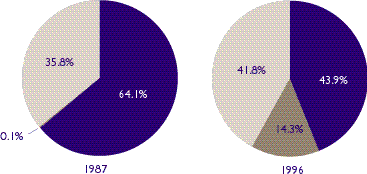
Return To Table Of Contents
What trends can be seen in nursing home supply and occupancy?
While the number of elderly has increased, the supply of nursing home beds per 1,000 people 75 and over has declined. At the same time, the overall occupancy rate declined from 92.3% in 1987 to 88.8% in 1996.
- In 1987 there were 127 nursing home beds per 1,000 people 75 years and over.
- In 1996 there were 117 nursing home beds for the same population, representing a 7.9% decrease in the supply of nursing home beds over the 9-year period.
Statistically significant declines in supply occurred in the Northwest and West regions of the United States from 1987 to 1996.
- Statistically significant declines in occupancy rates occurred in each region of the United States.
Return To Table Of Contents
Nursing home beds per 1,000 population 75 and over
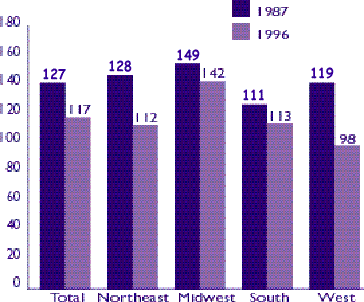
Return To Table Of Contents
Nursing home occupancy rate
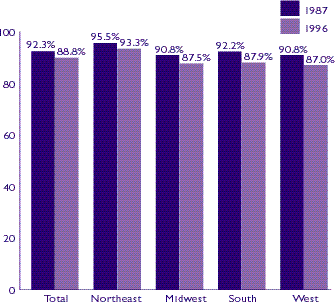
Return To Table Of Contents
Section 2: Special Care Units
Nursing homes are increasing the level of resources devoted to formal and
distinct care units for the specialized treatment needs of special populations.
Several trends have contributed to the creation of such units:
- Today's nursing home population is more frail and needs more skilled
and/or specialized care than was the case in 1987.
- Shorter lengths of stay in hospitals have resulted in a greater need for
skilled and rehabilitative care following hospitalization.
- Increasing public awareness of Alzheimer's disease and related dementia's
has increased interest in programs that provide services tailored to the
needs of persons with such conditions.
Which nursing homes have special care units?
Almost one-fifth of all nursing homes in 1996 had at least one distinct
special care unit. These special care units contained 120,400 beds, or 6.8% of
all nursing home beds.
- Among for-profit facilities, special care units were more common in
nursing homes that were part of a chain than in independent facilities
(22.0% versus 12.8%).
- The larger the nursing home, the more likely it was to have a special care
unit. The proportion of homes with a special care unit rose from only 4.2%
for facilities with less than 75 beds to 46.7% for facilities with 200 or
more beds.
Return To Table Of Contents
Percent of nursing homes with special care units, 1996
Ownership
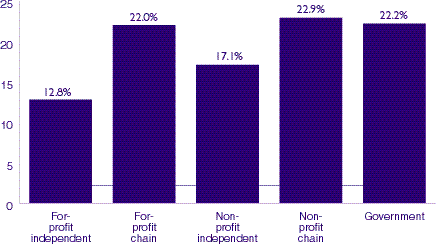
Return To Table Of Contents
Bed Size
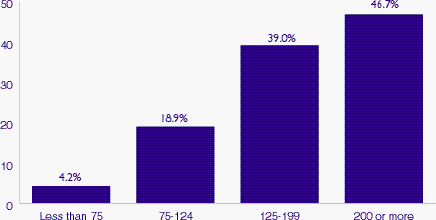
Return To Table Of Contents
What are the most common types of special care unit?
By far the largest category of special care units are for Alzheimer's disease
and related dementia's, which represented over half of all special care units
found in the sample.
- In 1996, 12.6% of nursing homes had an Alzheimer's unit. These units
accounted for 73,400 beds.
- Almost 5% of nursing homes had a distinct rehabilitation and/or subacute
special care unit. These units accounted for 28,500 nursing home beds.
- Just under 5% of nursing homes had either a ventilator unit or some other
type of special care unit (including hospice, AIDS/HIV, and brain injury).
These units accounted for the remaining 18,500 special care unit beds.
Return To Table Of Contents
Percent of nursing homes, 1996
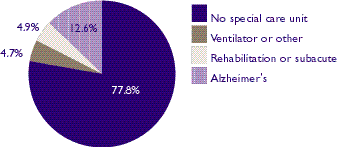
Return To Table Of Contents
Nursing home beds in special care units, 1996
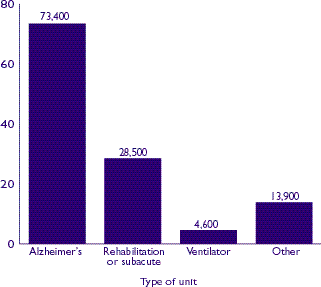
Return To Table Of Contents
How long have Alzheimer's units been in existence? How many beds do they
have?
Alzheimer's units are usually a relatively new phenomenon.
- In 1996, over half of Alzheimer's units had been in operation for 5 years
or less. Only about 10% had been operating for 11 years or more.
- Over half of Alzheimer's units had 16-40 beds, and three-quarters fell in
the range of 16-60 beds. Only about 9% had more than 60 beds.
See Technical Note 2.
Return To Table Of Contents
Alzheimer's units, 1996
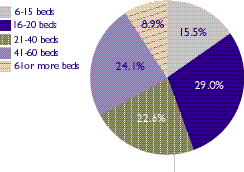 |
|
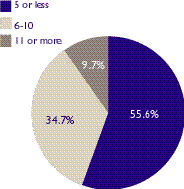 |
| Size |
|
Years in operation |
Return To Table Of Contents
Section 3: Residents
Despite the increasing availability of long-term care alternatives, such as
community-based care and personal care facilities, nursing homes continue to be
an important part of the long-term health care system. The nursing home
population represents a small proportion of both the elderly population and the
general population of people with disabilities. Nursing homes primarily serve
members of these populations who have severe medical and disability problems
that require nursing home care. A lack of financial resources or family
caregivers also contributes to the need for these institutions (Congressional
Budget Office, 1991).
Are nursing homes still serving the same age groups?
Nursing homes in 1996 served an older population than they served in 1987.
- The mean age for elderly residents (those 65 and over) increased from 83.5
years in 1987 to 84.6 years in 1996.
- Over the 9-year period there was a statistically significant rise in the
proportion of women residents who were 85 and over.
- In both years, about one-half of women, but only one-third of men, were 85
and over.
Return To Table Of Contents
Mean age of residents
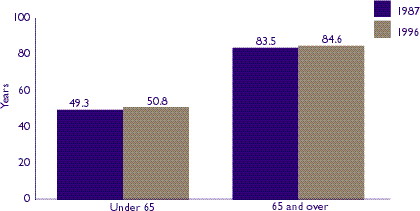
Return To Table Of Contents
Age and sex of nursing home residents

Return To Table Of Contents
Has the gender or racial composition of nursing homes changed?
The gender and racial composition of the nursing home population remained
unchanged from 1987 to 1996. The majority of nursing home residents were women
and the nursing home population remained almost entirely white.
- Women made up more than two-thirds of the nursing home population in both
1987 (73.4%) and 1996 (71.6%).
- In both years, approximately 90% of nursing home residents were white.
Return To Table Of Contents
Nursing home residents
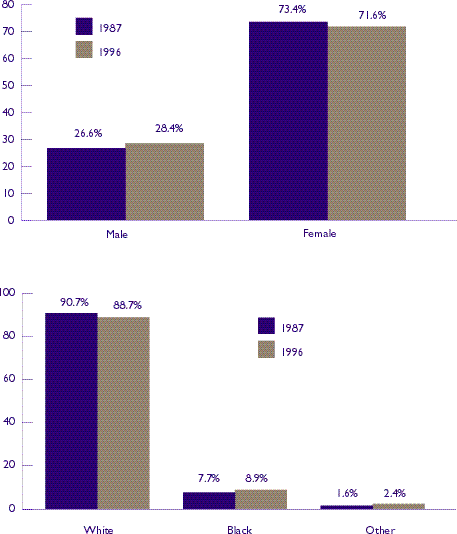
Return To Table Of Contents
Have the patterns of marital status for nursing home residents changed?
Although there was little significant change in marital status from 1987 to
1996, men and women present very different patterns.
- In both years, almost three-fourths of women but only one-third of men
were widowed at the time of the survey.
- The proportion of male residents who were married at the time of the
survey rose from 24.8% in 1987 to 34.3% in 1996 (an increase of 38.3%). The
proportion of male residents who had never married fell from 29.6% in 1987
to 21.5% in 1996 (a decline of 27.4%).
- Very little change occurred in the patterns of marital status for female
residents over the 9-year period.
Return To Table Of Contents
Marital status of nursing home residents
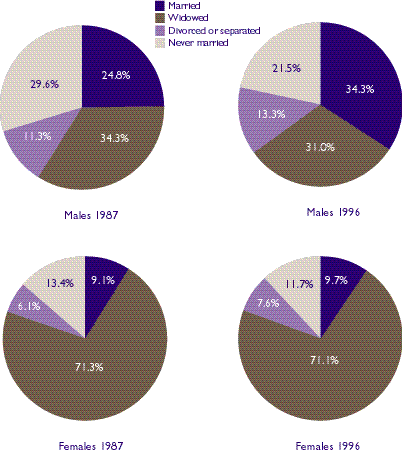
Return To Table Of Contents
Are nursing home residents more likely to be functionally disabled today
than in the past?
Measured by whether or not they received assistance with activities of daily
living (ADLs)—bathing, dressing, transferring, feeding, and
toileting—nursing home residents were more functionally disabled in 1996 than
in 1987.
- In 1987, 71.8 percent of nursing home residents received assistance with
three or more ADLs. By 1996 this proportion had risen to 82.9 percent—a
15.5% increase.
See Technical Notes 2 and 3.
Return To Table Of Contents
Nursing home residents
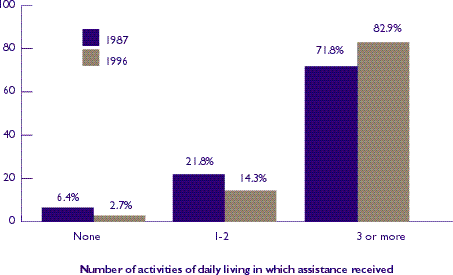
Return To Table Of Contents
Have inappropriate and dangerous behaviors increased among nursing home
residents?
Despite increases in the age and functional disability of nursing home
residents, the proportion of nursing home residents who exhibited inappropriate
and dangerous behaviors declined from 1987 to 1996. Such behaviors include being
physically abusive, wandering, and disruptive behavior (e.g., disruptive sounds,
inappropriate sexual behavior or disrobing in public, smearing or throwing food,
or hoarding).
- The proportion of nursing home residents who were physically abusive
decreased from 11.5% in 1987 to 9.1% in 1996.
- The proportion with disruptive behavior fell from 19.7% to 14.4% over the
same time period.
- The proportion with wandering behavior declined from 11.4% to 9.3%
See Technical Notes 2, 3,
and 4.
Return To Table Of Contents
Nursing home residents

Return To Table Of Contents
Conclusions
The data presented in this report suggest that:
- A large shift in the certification status of nursing
homes—from dual
certification by Medicare and Medicaid—corresponded with the
implementation of revised certification requirements mandated by the Omnibus
Budget Reconciliation Act of 1987.
- Depite an increase from 1987 to 1996 in the number of nursing homes and
nursing home beds, the supply of beds for the population 75 and over has
declined. Nonetheless, nursing home occupancy rates have fallen. This
suggests that the elderly's long-term care needs are increasingly being met
outside of nursing homes.
- Special care units are an important part of nursing home care. Units for
Alzheimer's and related dementia's are the most common type of special care
unit, with those for rehabilitation and subacute care being the next most
common.
- There is a growing interest in the providing more specialized
nursing home care. Most Alzheimer's units are relatively new, with over half
being in operation less than 6 years.
- From 1987 to 1996 the need to deliver skilled nursing care has increased.
Nursing home residents are older and have a greater degree of dependence in
1996 than in 1987.
Return To Table Of Contents
References
Burner S, Waldo D. National health expenditure projections, 1994-2005. Health
Care Financing Review 1995; 16(1):221-242
Congressional Budget Office (US). Policy choices for long-term care.
Washington: Congressional Budget Office; 1991.
Freiman M, Brown E. Special care units in nursing homes-selected
characteristics, 1996. Rockville (MD): Agency for Health Care Policy and
Research; 1999. MEPS Research Findings No. 6. AHRQ Pub. No. 99-0017. (Chartbook
pages 14-16)
Porter M, Witek J. The nursing home industry: past, present, and future.
Topics in Health Care Finance 1991; 17(4):42-48.
Rhoades J. Nursing homes-structure and selected characteristics, 1987 and
1996. Statistical Bulletin 1998; 79(2):2-9. (Chartbook pages 6, 9, and 12)
Rhoades J, Potter DEB, Krauss N. Characteristics of nursing homes in 1987 and
1996. Paper presented at the November 1997 Annual Meetings of the Gerontological
Society of America, Cincinnati, Ohio. (Chartbook pages 7, 8, 10, and 11)
Spillman B, Krauss N, Altman B. A comparison of nursing home resident
characteristics: 1987 to 1996. Paper presented at the November 1997 Annual
Meetings of the Gerontological Society of America, Cincinnati, Ohio. (Chartbook
pages 18-23)
Strahan, B. Nursing home characteristics: preliminary data from the 1985
National Nursing Home Survey. Hyattsville (MD): National Center for Health
Statistics, 1987. Advance Data From Vital and Health Statistics, No. 131. DHHS
Pub. No. (PHS) 87-1250.
Strahan, B. An overview of nursing homes and their current residents: data
from the 1995 National Nursing Home Survey. Hyattsville (MD): National Center
for Health Statistics, 1997. Advance Data From Vital and Health Statistics, No.
280. DHHS Pub. No. (PHS) 97-1250.
Please consult the MEPS Web site at http://www.meps.ahrq.gov
for an updated publications list or additional copies of this publication.
Return To Table Of Contents
Technical Notes
Note 1: A nursing home is defined as having at
least three beds and being either certified by Medicare or Medicaid or licensed
by a government agency as a nursing home and providing 24-hour skilled nursing
care.
Note 2: Estimates for years of operation for
Alzheimer's units, activities of daily living, and behavioral characteristics
have been adjusted for a small amount of item nonresponse.
Note 3: When it was reported that an activity of
daily living did not occur (e.g., the resident was unable to perform the
activity of daily living or was comatose), residents were classified as
receiving assistance with the activity. In order to be classified as independent
in toileting, residents who used wheelchairs had to be able to transfer
independently and those who did not use wheelchairs had to be independently
mobile.
Note 4: In 1996 disruptive behavior was measured
using a single question that included the definition from the Minimum Data Set
(MDS), which is a uniform series of questions assessing the nursing home
resident's physical and mental health. The MDS describes disruptive behavior as
follows: "made disturbing sounds, noisy, screams, self-abusive acts, sexual
behavior or disrobing in public, smeared/threw food/feces, hoarding, rummaged
through others' belongings." In 1987 information on disruptive behaviors
was elicited in a series of separate questions. Persons were identified as
exhibiting disruptive behavior if there was a positive response to any of the
following single items: hoarding, stealing, injuring self, dressing
inappropriately, or exposing self. In 1996 wandering behavior was measured using
the following MDS definition: "moved with no rational purpose, seemingly
oblivious to needs of safety." For 1987, wandering behavior was measured as
"getting lost or wandering." Return To Table Of Contents
| Suggested Citation: Chartbook #3: Nursing Home Trends, 1987 and 1996. May 1999. Agency for Healthcare Research and Quality, Rockville, MD.
http://www.meps.ahrq.gov/data_files/publications/cb3/cb3.shtml |
|
